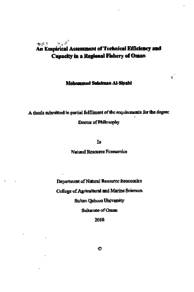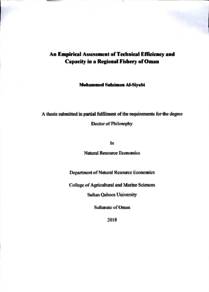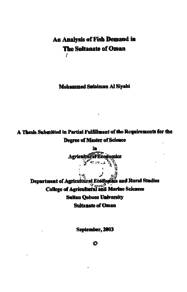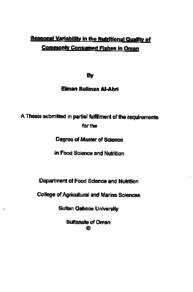Document
An empirical assessment of technical efficiency and capacity in a regional fishery of Oman
Publisher
Sultan Qaboos University
Gregorian
2018
Language
English
English abstract
In the context of small-scale fisheries, the interrelated issues of Capacity Utilization (CU) and Technical Efficiency (TE) have received global importance as they relate to the problem of overcapitalization and overfishing. Given the strategic importance of fisheries in Oman and limited research on these issues, the main objective of this study is to evaluate economic performance of the sector using regional fishery as a case study. More specifically, the study empirically examined the status of small-scale fisheries CU and TE of harvest and post-harvest operations.
To meet the objectives of the study Data Envelopment Analysis (DEA) was applied to analyse CU in the harvest sector, technical efficiency (TE) in both the harvest and post harvest sectors, and carried out cross-efficiency evaluation through risk minimization to identify top performing fishers. Furthermore, a questionnaire survey was conducted to collect relevant primary data used for the analysis of CU and TE involving both harvest and post-harvest sectors. Tobit regression techniques were used at the second-stage of DEA analysis to identify significant factors (that were not considered in the first-stage analysis) affecting CU and TE in the harvest sector and TE in the case of the post-harvest sector. In addition, descriptive and non-parametric statistics were used to analyse primary and secondary data. The study covered the period 2010-2012. The aggregated and/or average catch of three fish species categories namely large pelagic, demersal, and other species per fishing trip were used as output variables, while boat length, engine power, number of crews and fishing period were used as inputs in the first stage DEA under the assumption of both constant and variable returns to scales. The unbiased CU estimates reveal that, on average, the degree of CU of the sample boats is high however they may not be using variable inputs efficiently. It is, therefore, envisaged that, on average, there is potential for enhancing production without having to incur any additional costs with regard to acquisition of new physical capital and equipment. Furthermore, capacity output estimates provide a signal to the extent of excess capacity. The results also indicated that a large proportion of representative boats were operating in a technically inefficient manner and TE declines in majority of cases over the study period. A Similar downward trend is also noted in the distribution of scale efficiency estimate over the years and majority of boats was operating in the increasing returns to scale region. The results of the second-stage DEA showed that fishing location, Catch Per Unit of Effort (CPUE), fuel costs and crew share were statistically significant at the 5% level under Constant Returns to Scale (CRS), while subsidy and other operation costs were significant under Variable Returns to Scale (VRS) in the case of CU. With regard to TE, the combined model results under both CRS and VRS assumptions showed that 6 variables were statistically significant at the 5% level. Out of those 6 variables, the results of 4 variables, namely, age, education, subsidy and CPUE were common in both models. With regard to peer-assessment and risk minimization, a list of ten top performing fishers was presented.
In relation to post-harvest sector, the descriptive results indicated the highest variability in distribution time of fish products. The empirical results based on DEA analysis indicated that only 13% of DMUs were efficient under CRS and 18.2% under VRS assumption, respectively. Majority of fishers (more than 80%) were technically inefficient in dealing with their first-hand sale. More importantly, on average, about 72% of DMUS were not operating at the optimum scale of operation. The second-stage DEA analysis based on Tobit regression techniques suggested that age and education have negative association with TE while DMUs' relationship with buyers and their accessibility to central market exert positive influence on TE. These findings warrant appropriate attention from the management authority to improve operational efficiency of and better economic returns from the post-harvest sector. Based on these results, it is envisaged that there is potential for enhancing production and distribution without having to incur any additional costs with regard to new physical capital and equipment. Furthermore, capacity output estimates provide a signal to the extent of excess capacity. Regardless of the stage of development in the fisheries sector in Oman, the issue of efficiency deserve careful attention as a requirement to achieve its objectives stipulated in the strategic plan. Finally, policy implications of these findings are discussed. To gain a better understanding of harvesting operations in the small-scale fisheries sector in the country, it is prescribed that the management authority should extend this study for other coastal governorates and investigate the potential causes of inefficiency to help design effective management strategies.
Member of
Resource URL
Arabic abstract
حظيت القضايا المتعلقة بقدرة الإستغلال وكفاءة التقنية بإهتمام عالمي في مجال الصيد الحرفي من حيث صلتها بمشكلة الصيد الجائر والزيادة الغير مبررة لرأس المال العامل في القطاع السمكي، وبالنظر إلى الأهمية الاستراتيجية لمصاید الأسماك في سلطنة عمان وإلى البحوث المحدودة حول هذه القضايا فإن الهدف الرئيسي من هذه الدراسة هي تقييم الأداء الاقتصادي لقطاع الصيد الحرفي وتم إختيار الصيد الحرفي في محافظة ظفار كحالة دراسة، حيث تقوم هذه الدراسة على عمل تقييم تجريبي لقدرة الإستغلال وكفاءة التقنية لعمليات الصيد وما بعد الصيد، ولتحقيق أهداف هذه الدراسة تم استخدام تحليل تغلف البيانات، كما تم تقييم الكفاءة المشتركة للصيادين الحرفيين من خلال نهج تقييم الأقران مع تقليل المخاطر إلى أدنى حد لتحديد الصيادين ذوي الأداء الأعلى. وقامت الدراسة بعمل مسح ميداني لجمع البيانات الأولية ذات الصلة لتحليل قدرة الإستغلال وكفاءة التقنية شملت كلا من عمليات الصيد وبيع المصيد. ومن ناحية أخرى تم استخدام تقنيات الانحدار في المرحلة الثانية من التحليل لتحديد العوامل الهامة التي لم يتم التطرق إليه في تحليل المرحلة الأولى) والتي قد تؤثر على قدرة الإستغلال وكفاءة التقنية في عمليات الصيد بالإضافة إلى كفاءة التقنية في مرحلة بيع المصيد من قبل الصياد الحرفي. كما تم استخدام إحصائيات المعلمية والوصفية لتحليل البيانات الأولية والثانوية للدراسة غطت الدراسة الفترة 2010-2012، واستخدمت ثلاث مجموعات من الأسماك وهي أسماك السطح الكبيرة والأسماك القاعية بالإضافة إلى أنواع أخرى من الأسماك، بينما طول القارب وقوة المحرك وعدد الطاقم والفترة الزمنية لرحلة الصيد استخدمت كمدخلات للإنتاج في الدراسة خلال المرحلة الأولى من التحليل تحت إفتراضات العائد الثابت والمتغير كشفت نتائج قدرة الإستغلال إنه في المتوسط لا يتم إستخدام مدخلات الإنتاج بكفاءة، وهناك إمكانية تعزيز الإنتاج دون الاضطرار إلى تحمل تكاليف إضافية في رأس المال أو المعدات، وعلاوة على ذلك تؤكد النتائج على وجود قدرات إنتاج إضافية لم يتم إستغلالها في الصيد الحرفي، وأشارت النتائج أيضا إلى أن نسبة كبيرة من القوارب تعمل بطريقة غير كفؤة مع انخفاض كفاءة التقنية في معظم الحالات خلال فترة الدراسة، كما لوحظ اتجاها تنازليا في قدرة الاستغلال على مر السنين أظهرت نتائج التحليل في المرحلة الثانية أن موقع الصيد وجهد الصيد المقبروتكاليف الوقود وحصة الطاقم كانت ذات دلالة إحصائية عند مستوى 5% تحت العائد الثابت، في حين أن الدعم وتكاليف التشغيل الأخرى كانت مهمة تحت العائد المتغير في حالة قدرة الإستغلال، كما أظهرت نتائج النماذج المجمعة بموجب افتراضات العوائد الثابتة والمتغيرة أن ستة متغيرات ذات دلالة إحصائية عند مستوى 5٪ ومن بين هذه المتغيرات الستة، كانت نتائج أربع متغيرات وهي العمر والتعليم والدعم وجهد الصيد المقدرمتواجدة في كلا النموذجين. ومن ناحية أخرى قدمت الدراسة بناءا على تقييم أداء الصيادين من خلال تقليل مخاطر التقييم، قائمة تضم عشرة من الصيادين ذوي الأداء الأعلى والتي تعتبر مهمة المتخذي القرار. أشارت النتائج الوصفية فيما يتعلق بمرحلة بيع المصيد إلى طول الفترة الزمنية لبيع المصيد من الأسماك، وأشارت النتائج إلى أن 13% فقط من الصيادين في العينة كانوا يعملون بكفاءة في بيع المصيد تحت العائد الثابت و 18 . 2 % تحت العائد المتغير. وكان غالبية الصيادين (اكثر من 80%) غير أكفاء في التعامل مع بيعهم المباشر، كما أظهرت نتائج المرحلة الثانية من التحليل حسب المتوسط أن السن والتعليم لهما ارتباط سلبي مع كفاءة التقنية بينما علاقة الصيادين مع المشترين وإمكانية الوصول إلى السوق كان ذات تأثير إيجابية على كفاءة التقنية للصياد الحرفي وأخيرا ناقشت الدراسة بعض الإقتراحات للحصول على نتائج أفضل لعمليات الصيد وبيع المصيد في قطاع الصيد الحرفي والخروج باستراتيجيات فاعلة لإدارة القطاع السمكي في سلطنة عمان تستدعى هذه النتائج إهتمام متخذي القرار لتحسين الكفاءة التشغيلية وتعظيم العوائد الاقتصادية القطاع السمكي، حيث أن هناك إمكانية لتعزيز الإنتاج وتطوير التوزيع دون الاضطرار إلى تحمل أي تكاليف إضافية في رأس المال أو المعدات، وعلاوة على ذلك توجد كمية من القدرة الإنتاجية الفائضة والغير مستغلة وبغض النظر عن مرحلة التطور في القطاع السمكي بسلطنة عمان فإن مسألة الكفاءة تستحق الاهتمام من قبل متخذ القرار كمتطلب لتحقيق أهداف القطاع المنصوص عليها في الخطة الحالية والاستراتيجيات الموضوعة للقطاع.
Category
Theses and Dissertations




